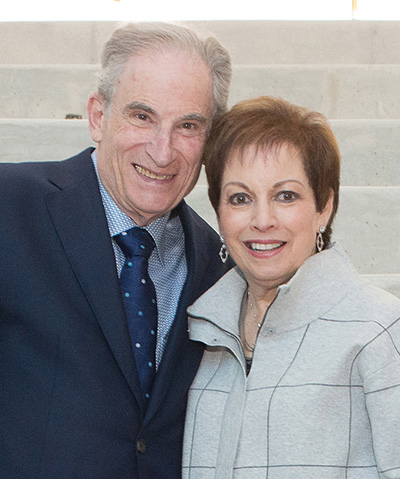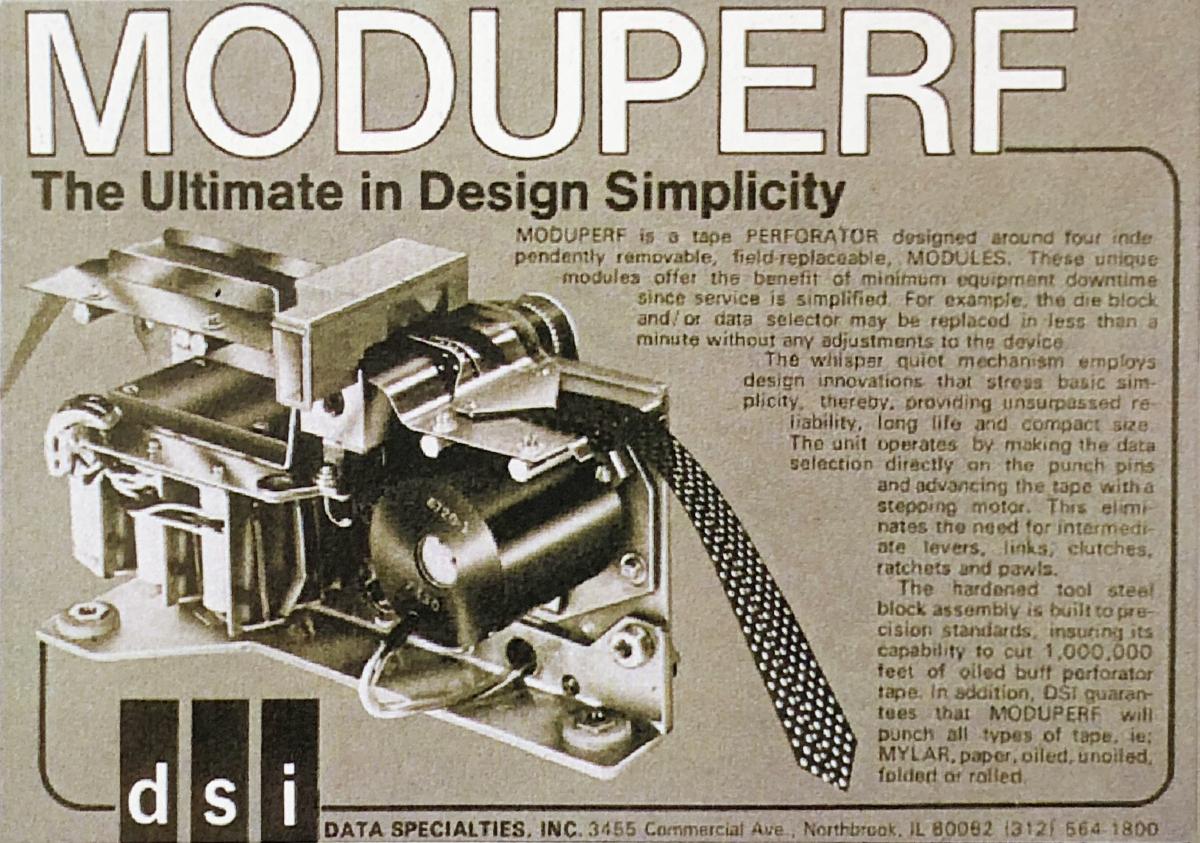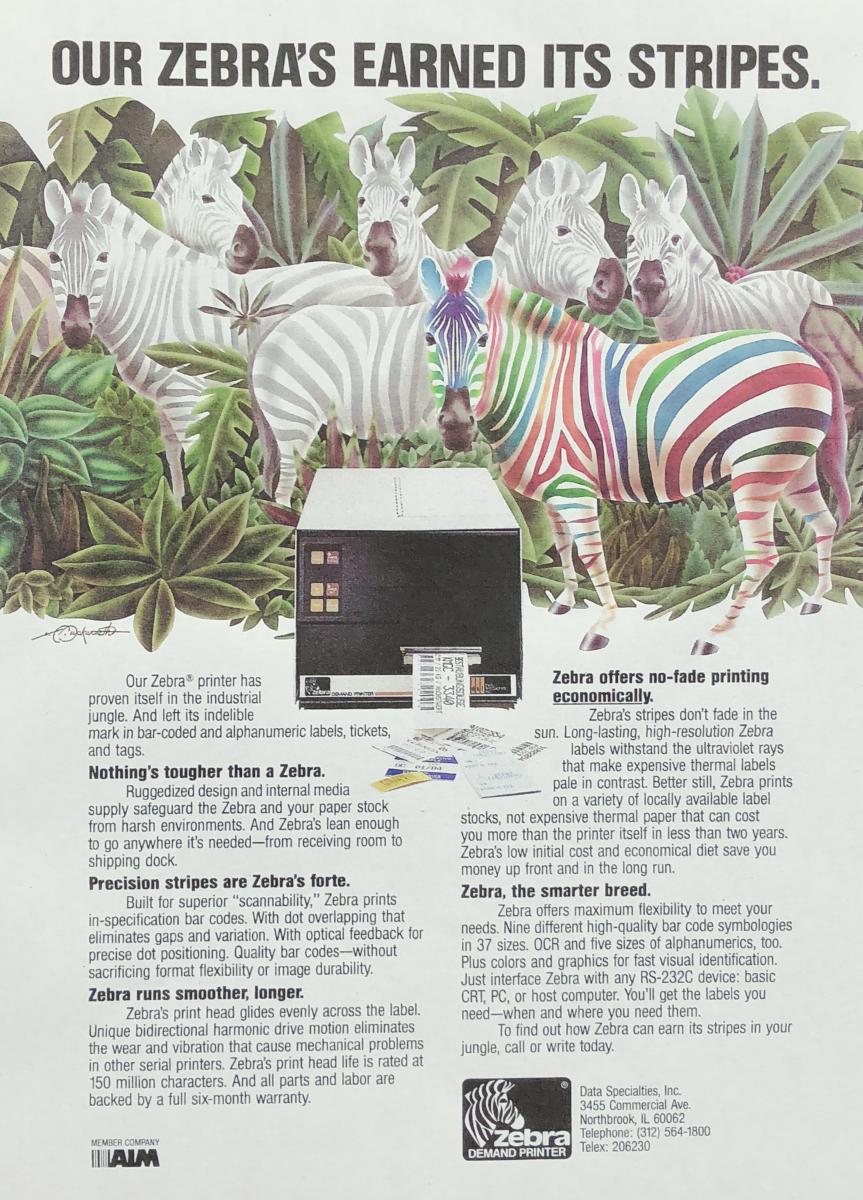
Too hyped up to even take a seat inside the cool conference room where we meet, Kaplan stands and provides a quick object lesson on a 500-milliliter plastic bottle of purified drinking water. He turns the bottle on its side and points to the black-and-white strip of lines and numbers—the barcode—that, in a sense, comprises the cornerstone of the Ed Kaplan Family Institute for Innovation and Tech Entrepreneurship.
“We had an entry product that was better, in some ways, than other printers that were in the marketplace,” recalls Kaplan about the duo’s first barcode printer, the MODUPRINT. “But we didn’t stop there. We went into what was called thermal transfer and a revolutionary printing technology that moved Zebra Technologies into the industry leader position. The MODUPRINT could print this,” Kaplan says, gesturing to the bottle’s barcode. “But it couldn’t print it as well or as fast or for the same price as the Z-130,” he adds, acknowledging the thermal transfer device that moved the company into the top tier.
Kaplan’s gaze shifts out the window 17 floors up and over an unobstructed view of Mies Campus to the north.
“I’m just a lucky guy who made some money, and that money is now invested in that white building and in the people who are going to be in that white building,” he says, nodding his head in the direction of the ethylene tetrafluoroethylene-paneled Kaplan Institute. “Universities could be about a lot of different things, but to me, the reason we’re building that institute is because we want to teach students to—by themselves or in collaboration with others—build a business, learning what it takes to go down that road.”
A few years before he retired in 2007 from the company that he co-founded, Kaplan prepared a thick binder’s worth of presentations that he wrote—what he calls “Zebra’s vision and guiding principles”—for management and other interested groups. Equal parts historical overview and business wisdom, the binder emphasizes the importance of all of the people involved in the evolution of building a successful company—from the staff and the suppliers to the customers. With his attention now focused on Illinois Tech’s students, Kaplan shares 10 pivotal moments—both high and low—in the history of Zebra Technologies that may serve them as guideposts of innovation and tech entrepreneurship.

- 1969AN IDEA SPARKS: A 26-year-old Ed Kaplan [left, in photo below], along with Teletype Corporation colleague (the late) Gerhard “Gary” Cless, form a part-time business—Data Specialties (DSI)—to design electromechanical equipment and “have some fun,” says Kaplan.

- 1969-1970UPS—AND WAY DOWNS: A client places an order for 500 data recorders. (A cash register sent transactions to the recorder, which encoded the data in the form of punched holes in a one-inch-wide paper tape.) Kaplan and Cless secure a one-time $10,000 bank loan and then return to the bank to plead for a second $10,000 loan to complete the job. After the duo purchases 200 sets of custom parts and delivers 25 data recorders, the client cancels the remaining job. “We were left with 175 sets of unique parts—nobody else could really use them,” says Kaplan. “This was a big problem for two young kids. What do we do with the parts and what do we do when we can’t pay our bills?” Their problems only increase. The duo places ads in trade publications to drum up business and receives an order from Florida for 1,000 teller terminal printers. After DSI delivers two prototypes, that client serves the company with a bogus lawsuit claiming that it showed drawings and prototypes to a competitor.
- 1971SCRAPPY SMARTS: Kaplan and Cless, who left their full-time jobs in 1970, borrow money from family and friends to launch a full-throttle sales campaign. They create the PMR-820 paper- tape perforator from the scrapped parts, and this decision enables their first real success.“I started to drive across the country (sleeping in my car at night) and demonstrated the PMR-820 to anyone who would let me in the door. A few months later, I received a call from one of the companies I visited asking if I could take an order for 100 units and ship 10 in a week. I just about fainted!” recalls Kaplan, with a laugh. “It was our first order for the PMR-820. I didn’t have to buy very much inventory because I had all of the old custom parts. How did we survive and ultimately prosper? This was when many of our values and principles started to emerge— commitment, focus, innovation, quality, and reliability.”
- 1973

BIG IDEA: The duo designs and constructs the MODUPERF modular paper-tape punch, an industry first. The device is billed as “The Ultimate in Design Simplicity.”

- 1982REALLY BIG IDEA: DSI introduces a product new to the barcode world with the MODUPRINT, a matrix label printer that features eight different barcode symbologies in 37 sizes.

- 1985-86KA-CHING!: Kaplan and Cless earn their stripes and change the name of their company to Zebra Technologies Corporation. They enter the upper echelons of the barcode industry with their introduction of the Z-130, a thermal transfer printer for on-demand barcode labeling.“Our thermal transfer printing of barcodes was a technological breakthrough at 200 dpi. We went from being a product to a labeling solution,” Kaplan explains. This thermal transfer technology no longer depends upon the use of temperature-sensitive paper for recording the impact dots that comprise the barcode lines and numbers. Now, barcodes can be printed on almost any surface, from foil to wax paper to plastic bottles.
- 1991BET THE RANCH: The privately held Zebra Technologies makes an initial public offering in 1991 and raises $40 million.“The $40 million was used to fund new product development and expand distribution channels, both domestic and international,” Kaplan explains.
- 1998KNOW YOUR GAME: Zebra Technologies merges with Eltron International, a provider of desktop and photo ID card printers for items such as driver’s licenses and access cards. Two years later, Comtec Information Systems, a leading provider of wireless mobile printers, joins Zebra.“Learn to stay close to your customer, anticipating their changing needs,” says Kaplan.The acquisitions enable Zebra Technologies to extend the barcode printer range and also add desktop printer competencies and products.
- 2007LEAVING A LEGACY: Kaplan retires after 37 years as Zebra’s chairman and chief executive officer to head Nalpak, Inc., a private investment firm.
- 2014GLOBAL LEADERS: Zebra Technologies acquires Motorola Solutions–Enterprise Business.“Zebra took a giant step,” says Kaplan. “The acquired company was more than twice Zebra’s size. Zebra is a company that has been extremely successful for perhaps all of its existence. It’s quite amazing.”


